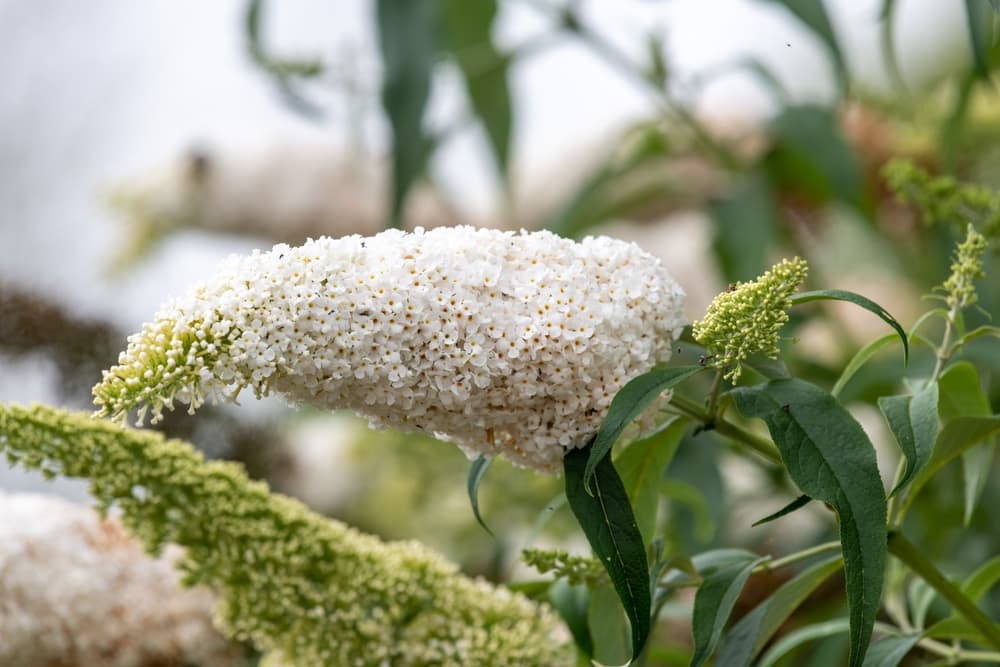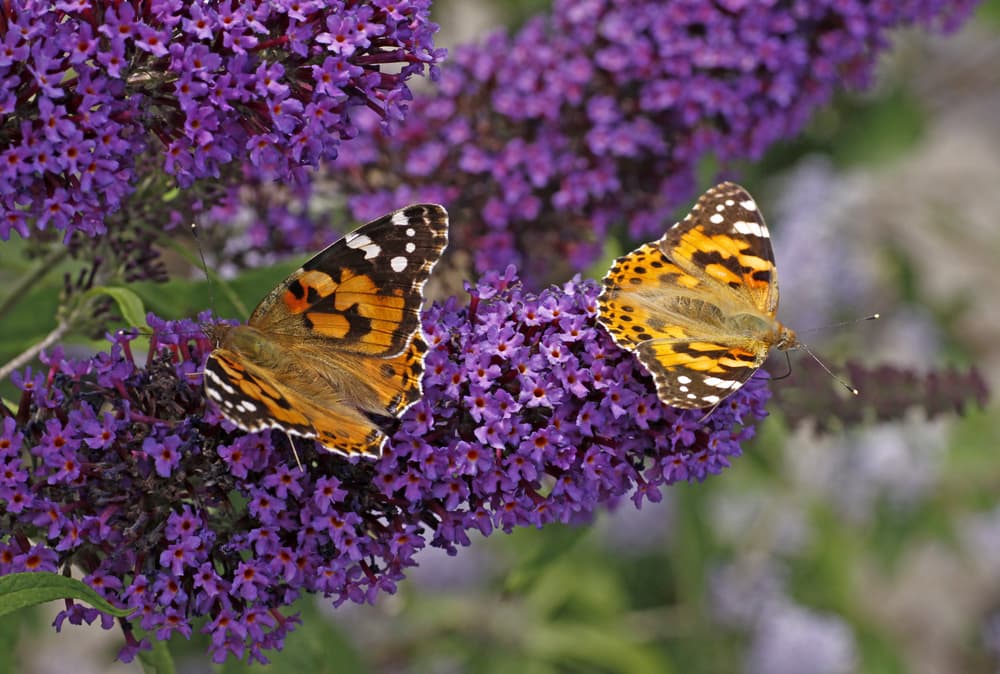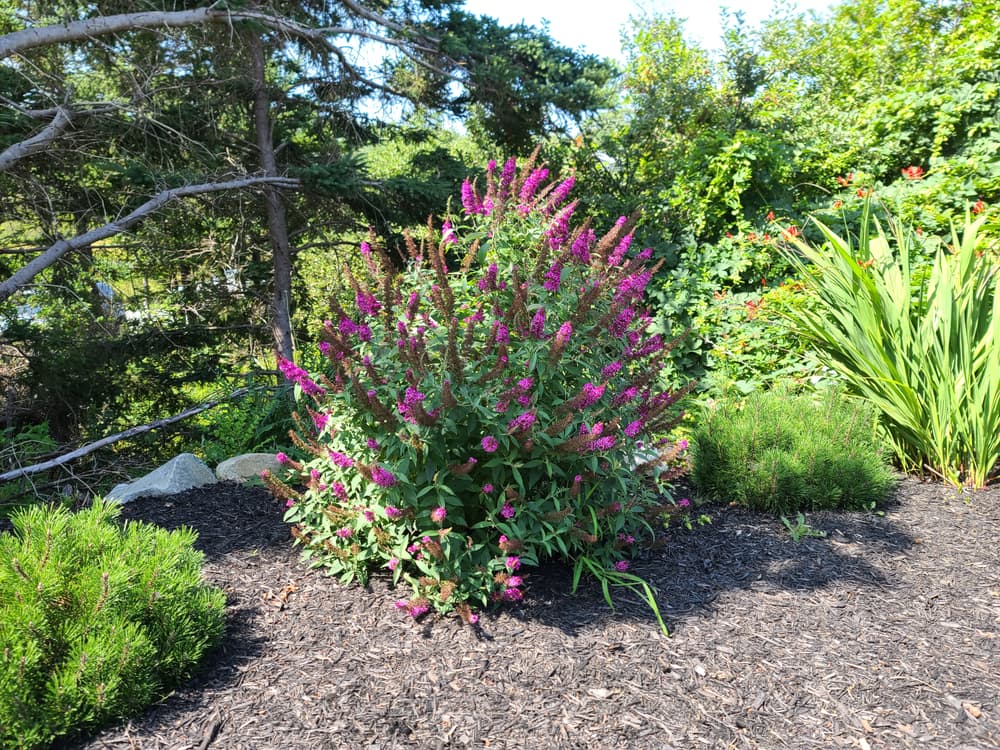SHRUBS > BUDDLEJA
Chris is a gardening writer and nature enthusiast. He graduated from Oxford Brookes University in 2022 with an MA in Psychology. Chris works with the Leeds Green Action Society, helping their food cooperative by growing various fruit and vegetables on their two allotments in Hyde Park, Leeds.
Reviewed By PETER LICKORISH

Peter is a Horticulture Lecturer and self-employed Horticulturist, with a passion for diverse areas of the industry - from garden design to the science behind plant growth and propagation. He has completed the Royal Horticultural Society’s Master of Horticulture (MHort) Award and lectures on RHS courses at Bedford College.
IN THIS GUIDE
BUDDLEJA GUIDES
Buddleja – often spelt ‘buddleia’ – is a beautiful and commonplace plant in British gardens.
Its splashes of purple, pink, and violet bring colour, and the sweet nectar brings butterflies and bees-a-plenty!
In fact, this plant is often called the butterfly bush because they love it so much.

There are tons of reasons to consider buddleja for your garden:
- It is versatile, hardy, and attractive.
- It comes in a veritable rainbow of colours.
- And the honey smell that is so enticing for pollinators is also quite appealing for a human nose!
In this article we’ll cover everything you need to know about buddleja, from choosing the right variety for your garden, through to planting, care, and ongoing maintenance tips.
Overview
| Botanical Name | Buddleja |
| Common Name(s) | Buddleia / ‘Butterfly Bush’ |
| Plant Type | Shrub |
| Native Area | Asia, Africa and the Americas |
| Hardiness Rating | H6 |
| Foliage | Simple leaves, usually deciduous |
| Flowers | Panicles of tubular flowers, usually purple or white |
| When To Sow | April, May |
| Flowering Months | June, July, August |
| When To Prune | March, August, September |
Sunlight
Preferred
Full Sun / Partial Shade
Exposure
Exposed or Sheltered
Size
Height
1.5 – 4M
Spread
1.5 – 4M
Bloom Time
June – August
Soil
Preferred
Most Soil Types
Moisture
Moist but well drained
pH
Any
This plant sits in the Scrophulariaceae family, alongside plants like Cape Fuchsia, Nemesia, Figwort, and others.1The Figwort Family or Scrophulariaceae and their Uses. (2021, December 8). Wonderful Weed Weekly. Retrieved April 25, 2023, from https://wonderfulweedweekly.co.uk/the-figwort-family-or-scrophulariaceae-and-their-uses/
There are several types, some deciduous and some evergreen.
The most commonly grown species are Chinese by origin, but have made themselves firmly at home in British gardens since their introduction.2The native range (provinces) of Buddleja davidii in China. (n.d.). Research Gate. Retrieved March 13, 2023, from https://www.researchgate.net/figure/The-native-range-provinces-of-Buddleja-davidii-in-China-are-shown-in-gray_fig2_226823556

Buddleja is popular for many reasons – we mentioned the fact that it is great for attracting butterflies: so much so that the RHS has chosen buddleja as one of its Plants for Pollinators.
It also blooms in August, which can be a quiet month in flowering gardens.
This makes it appealing to gardeners who want a garden that blooms for as much of the year as possible.
Finding the right variety comes down to deciding which colour you want, the size of the space you have to work with, and a few other factors.
Common Varieties
There are varieties of buddleja ranging from compact to sprawling.
Considering that size, colour, and shape vary between the different types, it’s worth familiarising yourself with each one before deciding which to plant.
“There are some really novel buddlejas out there, among my favourites are Buddleja x weyeriana and Buddleja globosa, which have pom-poms of yellow flowers,” says Master Horticulturist Peter Lickorish.
“The leaves are what will be on show for most of the year, so why not pick one with a unique leaf?
“‘Moonshine’ has golden-green leaves, which contrast sharply with pink flowers, or there’s ‘Summer Skies’ with variegated foliage.
“‘Summer Skies’ says it all in their name. For me, these plants are as much a part of summer’s joy as swallows, ice cream and beach holidays.”
‘Blue Horizon’

One of the most common types of buddleja (along with ‘Black Knight’).
If you’ve seen Buddleja before, Buddleja davidii is the species you’ll most likely recognise.
This is one of the popular cultivars of this species.
It can grow up to about four metres in height, over a period of five to ten years.
Alternate-Leaved Butterfly Bush

This species, also known as Buddleja alternifolia, is known to be less invasive than some others.
Gardeners who want to spend less time deadheading buddleja to prevent it seeding everywhere (more on that later) may be interested in this type.
B. alternifolia will reach similar heights to blue horizon, but over a slightly longer timeframe.
“This buddleja has slender leaves and its branches often hang downwards, meaning its character is a little like a weeping willow,” shares Peter.
‘Lochinch’

This hybrid of two types of buddleja is popular for its lavender colour, punctuated with orange dots.
It will grow slightly smaller than ‘Blue Horizon’ and B. alternifolia: up to a height of around two and a half metres.
‘Nanho Blue’ or ‘Nanho Purple’

A pair of more compact cultivars, reaching slightly smaller dimensions than the Lochinch.
They have bright blue or purple flowers, with orange centres on closer inspection.
These varieties are more manageable than the big, sprawling ones!
‘Dartmoor’

Named after the adventurous escapade required to collect cuttings from a ravine in Dartmoor, this hardy buddleja has a more rugged look than some other varieties.
It can grow up to 4m tall and has a nice magenta colour flecked with white.
“Unlike most other buddlejas, its flower panicles are branched, so appear much larger,” says Peter.
“They’re so heavy they pull the tips of branches downward!”
The Butterfly Buddlejas

Some buddleja varieties are named after butterflies with similar coloured wings to their flowers.
‘Marbled White’, ‘Adonis Blue’, and ‘Purple Emperor’ are three examples.
It’s worth noting that while buddleja is great at attracting butterflies, they don’t use the plant as part of their breeding cycle.
This means they’ll come to feed, then head elsewhere when it’s time to make the next generation of caterpillars.
How To Grow Buddleja
This plant doesn’t take much work.
You can tell from the fact that it grows quite happily in untended land, alongside railway tracks, and other areas that aren’t actively gardened.
In fact, most of the work you’ll be doing will be preventing your buddleja from growing too much, or from seeding itself all over your garden.
Planting Guidelines
Buddleja prefers being planted in fairly warm soil, so you’re best waiting until later spring months.

If you’re growing from a container or planting out stronger saplings these can be planted up until the end of August.
“Until they get their roots down, they will need a lot of watering, especially if planted in summer,” adds Peter.
Before planting, ensure the soil is loose, and mix in some compost.
Place your buddleja plant into a hole with a diameter about twice that of the pot you’re planting out of.
The top of the roots should be level with the surface of the soil.
Soil Requirements
This plant favours dry soil, and will not thrive in soil that holds a lot of water, especially in winter.
They usually prefer alkaline soil, so check the pH is suitable.

Buddleja is a great choice if you have a coastal garden, thanks to its hardy nature and ability to grow in chalky soils.
It can even tolerate salt-laden winds.
Spacing
Most varieties need to be planted about 2m apart to give them space to grow strongest.
While this may seem like a lot of space when planting small shrubs, bear in mind just how voluminous this plant can get later in its lifecycle!
Positioning
To thrive, buddleja should be in a warm and sunny position in your garden.
They need a few hours of sunlight each day, at least.
This stimulates maximum nectar, making things as sweet as possible for the bees and butterflies.

Plant Care
As we’ve said, this is a fairly hardy plant that can look after itself quite comfortably.
There are a few things to keep an eye on, though, to give the best chances of survival.
Watering
If rainfall is lower than two or three centimetres in summer, water your buddleja.
Otherwise, the rain should take care of it.
Remember this plant is drought-resistant, so will not need to be watered as much as some other plants in your garden.
“Potted or recently planted buddlejas will rely much more on you for watering,” warns Peter.

In spring, when the buddleja is growing freely, you can water it fairly frequently.
Hold back in the autumn months though: this plant does not thrive in very wet conditions.
Fertilising
Mulching buddleja with manure or adding some organic fertiliser is a good way to increase the number of flowers for most plants, although some gardeners advise that for buddlejas, it may actually stimulate the growth of foliage instead.
There is a difference of opinion on whether buddleja should be fertilised.
If you do decide to, manure should be placed in autumn; fertiliser in late spring.

Adding a new layer of compost or mulch each spring will keep moisture in and reduce the build-up of weeds.
“Feeding is more important for potted plants, where a slow or controlled release fertiliser, often in granule form, will gradually break down and feed the plant,” shares Peter.
Particularly big buddlejas will begin to look like trees, and their trunks may peel – if this happens, don’t panic! It’s normal.
Common Problems
This is a notably hardy plant.
Particularly strong winds can blow branches off of larger buddleja plants, but aside from that, it will most likely keep itself out of harm’s way.
“If it is exposed to cold winds, consider reducing long branches by a third before the worst of winter’s weather,” explains Peter.
Here are a few other potential threats to look out for:
Pests
Buddleja is prone to several bugs, including mites, nematodes, and caterpillars.
The mites, which are often red spider mites, are small and hard to see, but if you suspect your plant is infected, a good way to find out is to shake a branch and hold a sheet of paper below.
If small orange or green mites fall onto the paper, then give the plant a good blast with a hose to remove them.
“Damaged parts of the plant, usually showing a fine yellow mottling on the leaves, can be cut out,” explains Peter.

If foliar nematodes take hold, they are harder to get rid of.
Their damage can look similar, with yellow leaf blotches.
The priority here becomes keeping the plant healthy and ensuring it gets all the nutrients it needs; take extra care not to overwater or get the leaves wet in this circumstance, as nematodes thrive in moist conditions.
Plant Diseases
Buddleja is also more prone to mildew when left damp for a long period of time – another reason not to overwater.
If you find mildew on your plant, remove those stems.
You’ll be able to tell by the leaves becoming yellow at the top, or by patches of white mildew on their underside.
Root diseases can affect buddleja, and again the risk increases with overwatering.

If you see small, yellow flowers, this could be why, or wilting during damp weather.
Improving drainage is the first step: sometimes the problem will take care of itself; if not, applying a fungicide to the roots may help.
It’s worth noting that while rare, these diseases can kill buddleja.
The takeaway then? Take extra special care not to overwater this plant!
And That’s All…
Buddleja is a bold, bright, and beautiful plant.
There are plenty of varieties, meaning it’s available in pretty much all shapes and sizes.
Choosing the right buddleja for your garden is essentially a case of deciding how big you want it to grow, and what colour you want it to be.
Because it’s so hardy, buddleja requires less work than many other plants – in fact, the main work you’ll be doing is pruning it back!
References
- 1The Figwort Family or Scrophulariaceae and their Uses. (2021, December 8). Wonderful Weed Weekly. Retrieved April 25, 2023, from https://wonderfulweedweekly.co.uk/the-figwort-family-or-scrophulariaceae-and-their-uses/
- 2The native range (provinces) of Buddleja davidii in China. (n.d.). Research Gate. Retrieved March 13, 2023, from https://www.researchgate.net/figure/The-native-range-provinces-of-Buddleja-davidii-in-China-are-shown-in-gray_fig2_226823556

